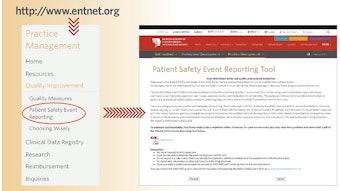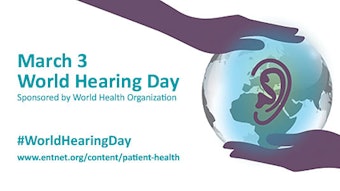Clinical Practice Guideline: Updates to improve quality of care for patients with Dysphonia
Dysphonia affects nearly one-third of the population at some point in their lives. The primary purpose of the Clinical Practice Guideline Hoarseness (Dysphonia) (Update) is to improve the quality of care for patients with dysphonia, based on current best evidence.
Adapted from the March 2018 supplement to Otolaryngology–Head and Neck Surgery. Read the guideline at www.otojournal.org.

Dysphonia affects nearly one-third of the population at some point in their lives. The primary purpose of the Clinical Practice Guideline Hoarseness (Dysphonia) (Update) is to improve the quality of care for patients with dysphonia, based on current best evidence. Expert consensus to fill evidence gaps, when used, is explicitly stated and supported with a detailed evidence profile for transparency. Specific objectives of the guideline are to reduce inappropriate variations in care, produce optimal health outcomes, and minimize harm.
The 2018 guideline update was chaired by Robert J. Stachler, MD, with David O. Francis, MD, MS, serving as assistant chair, and Seth R. Schwartz, MD, MPH, as the methodologist.
The prior guideline was published in 2009 and allowed for up to three months of symptoms prior to laryngeal evaluation in patients without significant concerns, said Dr. Stachler, a clinical associate professor at Wayne State University. The update shortens the amount of time allowed before performing a laryngoscopy in all patients. The updated guideline incorporates new evidence profiles to include the role of patient preferences, confidence in the evidence, difference of opinion, and quality improvement opportunities. It also includes considerations from three related new guidelines, 16 new systematic reviews, and four new randomized controlled trials.
“A lot of work has gone into making sure that the perspective of all stakeholders has been taken into account,” said Dr. Stachler. “We addressed things that were contentious after publication of the first guideline. Primarily we address the timing of laryngoscopy for persistent dysphonia. As in the original guideline, physicians may perform diagnostic laryngoscopy at any time, especially for patients with higher level of concern. For all patients with dysphonia, we clarified that earlier evaluation of the larynx is beneficial.”
The guideline update was endorsed by the following organizations: American Academy of Otolaryngic Allergy (AAOA); Society of Otorhinolaryngology and Head-Neck Nurses (SOHN); National Association of Teachers of Singing (NATS); National Spasmodic Dysphonia Association (NSDA); American Broncho-Esophagological Association (ABEA); American Laryngological Association (ALA); American Speech-Language-Hearing Association (ASHA); American Society of Pediatric Otolaryngology (ASPO); American Academy of Pediatrics (AAP); American College of Chest Physicians (ACCP); and American Academy of Physical Medicine and Rehabilitation (AAPM&R).
An Affirmation of Value for the guideline update was received from the American Academy of Family Physicians (AAFP).
The full guideline, and its other resources, are available at http://www.entnet.org/content/clinical-practice-guidelines and in the March Otolaryngology–Head and Neck Surgery journal at www.otojournal.org.
This guideline applies to all age groups evaluated in a setting where dysphonia would be identified or managed. It is intended for all clinicians who are likely to diagnose and manage patients with dysphonia.
Identification of Abnormal Voice
Clinicians should identify dysphonia in a patient with altered voice quality, pitch, loudness, or vocal effort that impairs communication or reduces quality of life.
Identifying Underlying Cause of Dysphonia
Clinicians should assess the patient with dysphonia by history and physical examination for underlying causes of dysphonia and factors that modify management.
Escalation of Care
Clinicians should assess the patient with dysphonia by history and physical examination to identify factors where expedited laryngeal evaluation is indicated. These include but are not limited to recent surgical procedures involving the head, neck, or chest; recent endotracheal intubation; presence of concomitant neck mass; respiratory distress or stridor; history of tobacco abuse; and whether the patient is a professional voice user.
Need for Laryngoscopy in Persistent Dysphonia
Clinicians should perform laryngoscopy, or refer to a clinician who can perform laryngoscopy, when dysphonia fails to resolve or improve within four weeks or irrespective of duration if a serious underlying cause is suspected.
Laryngoscopy Prior to Voice Therapy
Clinicians should perform diagnostic laryngoscopy, or refer to a clinician who can perform diagnostic laryngoscopy, before prescribing voice therapy and document/communicate the results to the speech-language pathologist.
Advocating for Voice Therapy
Clinicians should advocate voice therapy in patients with dysphonia from a cause amenable to voice therapy.
Surgery
Clinicians should advocate for surgery as a therapeutic option for patients with dysphonia with conditions amenable to surgical intervention, such as suspected malignancy, symptomatic benign vocal fold lesions that do not respond to conservative management, or glottic insufficiency.
Botulinum Toxin
Clinicians should offer, or refer to a clinician who can offer, botulinum toxin injections for the treatment of dysphonia caused by spasmodic dysphonia and other types of laryngeal dystonia.
Education/Prevention
Clinicians should inform patients with dysphonia about control/preventive measures.
Outcomes
Clinicians should document resolution, improvement, or worsened symptoms of dysphonia, or change in quality of life among patients with dysphonia after treatment or observation.
Imaging
Clinicians should not obtain computed tomography (CT) or magnetic resonance imaging (MRI) among patients with a primary voice complaint prior to visualization of the larynx.
Antireflux Medication and Dysphonia
Clinicians should not prescribe antireflux medications to treat isolated dysphonia, based on symptoms alone attributed to suspected gastroesophageal reflux disease (GERD) or laryngopharyngeal reflux (LPR), without visualization of the larynx.
Corticosteroid Therapy
Clinicians should not routinely prescribe corticosteroids for patients with dysphonia prior to visualization of the larynx.
Antimicrobial Therapy
Clinicians should not routinely prescribe antibiotics to treat dysphonia.
Laryngoscopy and Dysphonia
Clinicians may perform diagnostic laryngoscopy at any time for a patient with dysphonia.
Guideline authors
Robert J. Stachler, MD; David O. Francis, MD, MS; Seth R. Schwartz, MD, MPH; Cecelia C. Damask, DO; German P. Digoy, MD; Helene J. Krouse, PhD, RN, ANP-BC, CORLN; Scott J. McCoy, DMA; Daniel R. Ouellette, MD; Rita R. Patel, PhD, CCC-SLP; Charles (Charlie) W. Reavis; Libby J. Smith, DO; Marshall Smith, MD; Steven W. Strode, MD, Med, MPH; Peak Woo, MD; and Lorraine C. Nnacheta, MPH
AAO-HNSF Guideline development process and the obligations associated with the guideline recommendations are documented in the Clinical Practice Guideline Development Manual, Third Edition: a quality-driven approach for translating evidence into action (http://oto.sagepub.com/content/148/1_suppl/S1.long).
Disclaimer
The clinical practice guideline is provided for information and educational purposes only. It is not intended as a sole source of guidance in managing hoarseness (dysphonia). Rather, it is designed to assist clinicians by providing an evidence-based framework for decision-making strategies. The guideline is not intended to replace clinical judgment or establish a protocol for all individuals with this condition and may not provide the only appropriate approach to diagnosing and managing this program of care. As medical knowledge expands and technology advances, clinical indicators and guidelines are promoted as conditional and provisional proposals of what is recommended under specific conditions, but they are not absolute. Guidelines are not mandates; these do not and should not purport to be a legal standard of care. The responsible physician, in light of all circumstances presented by the individual patient, must determine the appropriate treatment. Adherence to these guidelines will not ensure successful patient outcomes in every situation. The AAO-HNSF, Inc emphasizes that these clinical guidelines should not be deemed to include all proper treatment decisions or methods of care or to exclude other treatment decisions or methods of care reasonably directed to obtaining the same results.
Downloadable PDF Files:
voice_therapy.pdf | Hoarseness.pdf | Hoarseness_Prevention.pdf










